The Evolution of Single-Use Technologies in Aseptic Processing
The authors describe the origins of single-use components and explain their application to aseptic processes. They also show how disposable devices have changed over time and offer a glimpse of the future.
For the past decade, the development and approval of biological drugs has increased rapidly. This increase highlights the significance of aseptic processing because biologics commonly cannot be heat sterilized. Because aseptic processing receives greater regulatory scrutiny than heat sterilization does, the industry developed, in addition to risk-management and risk-analysis activities, new processing equipment and technologies to overcome potential weaknesses (1). These technologies' main purpose was the avoidance of human intervention, which is one of the most substantial risks in aseptic processing. The technologies included environmental-containment solutions such as isolators and restricted-access barrier systems, and new filling strategies such as blow–fill–seal. Disposable solutions have changed, and their applications have broadened, during the past several years.
The most far-reaching changes in the technology's early days affected processing equipment, which gradually was converted into single-use equipment (2). The benefits of single-use equipment not only enable a potentially higher sterility-assurance level within process steps than was possible before, but also enable production-utilization enhancements, cost savings, and end-user protection. Single-use equipment does not require setup times of 8–10 h or copious amounts of water for cleaning purposes (3). Furthermore, it protects end users from contact with potentially hazardous fluids. This article will focus on recent advances in single-use technologies.
The development of single-use equipment
The first disposable process parts to be used were tubing sets. They were followed by filtration devices called capsule filters. Capsule filters were only available in small effective-filtration-area units, commonly between 0.5 and 2 ft2. The introduction of single-use components for mixing and fluid containment required larger filter capsules, and end users requested small-scale pleated devices for scaling studies. These two factors led the filter-capsule range to be expanded to an area of 0.1 to 30 ft2 (4–6). Current filter capsules are gamma-sterilizable and commonly connected to tubing sets or bag assemblies (see Figure 1).
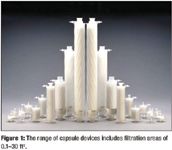
Figure 1 (IMAGES ARE COURTESY OF THE AUTHORS)
Single-use technology for mixing and holding tanks also emerged (e.g., single-use bag devices). Single-use bags are available in volumes of 20 to 3000 L and can replace glass vessels, carboys, and stainless-steel tanks. Before single-use bags could be introduced into the production process, they needed to demonstrate mechanical stability, chemical resistance, a barrier to oxygen transfer, and low leachable levels, even when the bags were gamma sterilized at 50 kGy. New polymeric films laminated onto each other made these characteristics possible and have become common (see Figure 2).
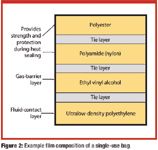
Figure 2
Single-use bags are used most often in an assembly format, either with or without a filter, as part of a multibag system. The entire assembly is gamma irradiated in the packaging and is ready to use.
Single-use systems, though, are not restricted to bags and filters. Various equipment components are available that can be combined into a single-use system or process step. Such equipment components include the following:
- Mixing systems of various designs and volumes
- Sensors (e.g., for dissolved oxygen, pH, and conductivity)
- Sterile fluid-transfer connectors and tubing
- Fluid-sampling devices
- Bioreactors of different designs, volumes, and agitation technologies)
- Aseptic-transfer systems for fluids and solids
- Freeze–thaw bags
- Ultra- and diafiltration
- Membrane-chromatography (e.g., ion exchange) columns (7, 8)
- Viral-clearance and ultraviolet-inactivation filters.
Future single-use processes
At first, single-use components were designed to be connected to a traditional unit operation. The newest advance in technology combines single-use components into a single-use unit operation. One day, these unit operations likely will be connected together to form a single-use process (see Figure 3).
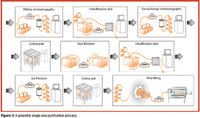
Figure 3
Single-use unit operations currently are available for buffer and media preparations, ultra- and diafiltration, virus filtration, and bioreactors. Other process steps will follow soon, and low-volume streams inevitably will be processed within single-use designs in the near future. Large volumes probably will still need to be processed in hybrid solutions, which connect reusable and single-use process steps.
New disposable sensor technologies will ensure that process analytical technology needs are not neglected. Radio-frequency identification tags will enable the end user to connect systems safely and track systems during inventory-management or transfer activities.
Limitations such as mechanical instability at large volumes and cost factors within affinity chromatography will restrict the development of single-use processes (see Figure 4). Despite these limitations, the advantages of reduced setup times, the elimination of cleaning activities, and end-user protection justify converting even a small number of process steps to single-use technologies. Eliminating end-user intervention with presterilized, interconnected unit operations potentially can enhance safety within aseptic processing. Single-use technology inevitably will be an essential component within biopharmaceutical processes, even if the majority of components in a process is not single-use.
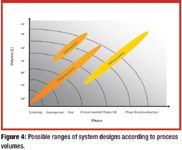
Figure 4
Validation and qualification needs
The validation requirements for a single-use aseptic process are the same as those for a traditional stainless-steel process. Because single-use systems are preassembled and presterilized by the vendor, the validation work requires a high level of vendor involvement. The end user works closely with the vendor to determine the specific validation and qualification parameters and activities needed to ensure the expected product performance for a given application. The vendor, therefore, must have an in-depth understanding of current regulatory requirements and good manufacturing practices. Moreover, the vendor must be able to adjust to the end user's needs. Every application and process stage has different specifications and critical aspects. These differences must be taken into consideration to avoid working too much or too little to satisfy validation requirements.
Most single-use systems are gamma-irradiated at 25–50 kGy. The irradiation sterilization makes short- and long-term stability studies necessary to evaluate potential polymeric degradation, which could raise leachable levels or lower mechanical resistance. Irradiation commonly reduces the shelf life of polymeric devices, and personnel must determine the radiation limit that a given device can withstand. Qualification tests, defined by the vendor, are performed before any single-use unit or system is distributed to the industry. These qualification tests are manifold and are designed to meet regulatory requirements (see Table I). The end user can rely on the results of the vendor's qualification tests, but should consider process-specific validation requirements.

Table I: Common qualification tests performed by single-use equipment vendors.
Process-validation studies would, for example, use a model solvent and simulate the process parameters within the end user's specifications. Leachable testing cannot always be performed with the product because the product would mask potential peaks. For this reason, model solvents that are similar to the solvent used within the product stream often are chosen. The possible influence of the environmental conditions within the end user's processes should be tested, however, to ensure that the disposable device performs to specifications. Process-validation steps vary according to disposable devices' purposes. Sterilizing-grade filters must undergo a product bacteria-challenge test under end users' process conditions. The influence of the process conditions and fluid on the challenge organisms or separation mechanisms should be determined. Product hold bags or mixing bags do not have to undergo bacteria-challenge tests, but possibly bacteria-ingress tests. Both filter and bag systems must be tested for leachables and extractables. As mentioned previously, the end user should request the vendor's assistance.
Conclusion
Many single-use devices already are available, most commonly as individual entities. More and more filter–bag and bioreactor–filter systems have been introduced, and single-use unit operations recently have become available. Components' rapidly developing connectivity will enhance the development of integrated systems and, potentially, totally disposable processes. Some limitations, especially in the filling area still must be overcome (e.g., fill precision). The last step in aseptic processing has not reached the level of disposability that one finds in the intermediate steps.
Single-use components have many benefits within aseptic processes. For example, cleaning deficiencies are a common regulatory observation that would be eliminated by single-use equipment. The equipment also greatly reduces the risk of cross contamination. Moreover, disposable, aseptic connectivity will reduce end-user manipulation within the process and therefore improve safety. Some in the industry have wondered whether the benefits of single-use systems are outweighed by their environmental impact. Further studies and thorough evaluations, however, might show that the environmental impact of cleaning and sterilizing stainless-steel equipment is greater than that of single-use systems. This topic will likely be addressed in the near future.
Maik W. Jornitz* is vice-president of marketing FT/FRT, and Thomas Paust is global director of marketing IS, both at Sartorius Stedim North America, 5 Orville Dr., Bohemia, NY 11716, tel. 631.254.4249, maik.jornitz@sartorius-stedim.com. Jornitz also is chair of the Parenteral Drug Association.
*To whom all correspondence should be addressed.
References
1. EudraLex, Concerning Medicinal Products for Human and Veterinary Use, Vol. 4, Annex 1, p. 12 (European Union, Brussels, 2008).
2. P.M. Priebe, PDA SciTech Conference (Orlando, FL, 2004).
3. A. Sinclair and M. Monge, Pharm. Eng. 22 (3) 1–9 (2002).
4. M.W. Jornitz et al., Genet. Eng. News 24 (13), 50–51 (2004).
5. PDA, "Liquid Sterilizing Filtration," Technical Report 26 (Parenteral Drug Association, Bethesda, MD, 2008).
6. M. Rios, Pharm. Technol. 27 (9), 46–56 (2003).
7. J. Mora, BioProcess Int. supp. 4, 38–43 (2006).
8. J.X. Zhou and T. Tressel, BioProcess Int. 3 (9), 32–37 (2005).
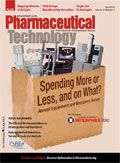
PacBio Chosen as Tech Partner for Global Alzheimer’s Disease Research Project
April 23rd 2025The project, the North African Dementia Registry, will unite multiple entities for the purpose of developing a comprehensive dataset to advance the research community’s understanding of Alzheimer’s disease and other dementias in diverse populations.
Drug Solutions Podcast: A Closer Look at mRNA in Oncology and Vaccines
April 30th 2024In this episode fo the Drug Solutions Podcast, etherna’s vice-president of Technology and Innovation, Stefaan De Koker, discusses the merits and challenges of using mRNA as the foundation for therapeutics in oncology as well as for vaccines.